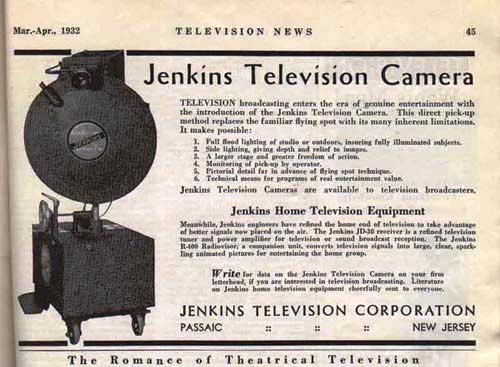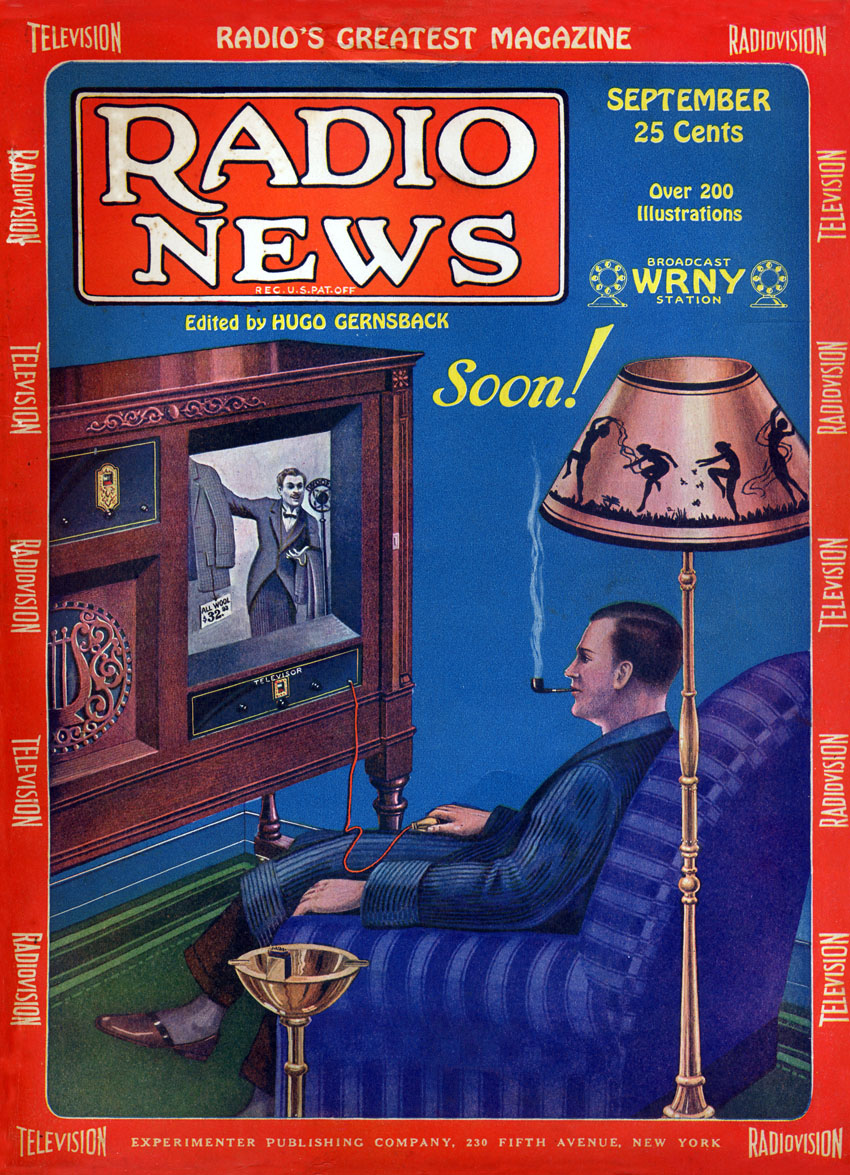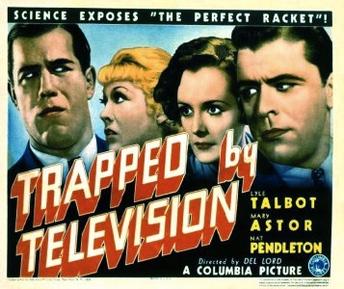
From left to right: Michele Hilmes, Susan Murray, Doron Galili, Philip Sewell
The Wisconsin Center for Film and Theater Research was honored to co-sponsor portions of the Radio Preservation Task Force Conference, held at the Library of Congress in Washington, D.C. from April 27-30, 2023. One of the WCFTR’s co-sponsored sessions was a discussion with Dr. Doron Galili (a Research Fellow in the Department of Media Studies at Stockholm University) about his book Seeing by Electricity: The Emergence of Television, 1878–1939 (Duke University Press, 2020). The discussion was moderated by Dr. Michele Hilmes, emeritus professor in the Communication Arts Department and a former director of the WCFTR, and also featured Dr. Susan Murray (BA, UW-Madison) and Dr. Philip Sewell (PhD, UW-Madison). We invited Dr. Galili to contribute to the WCFTR blog and expand on some of the reflections he shared at the conference about archives and broadcasting history.
Doron Galili
In April 2023, the Radio Preservation Task Force of the Library of Congress hosted a major conference in celebration of a century of broadcasting. The conference brought together radio and television scholars and media archivists to discuss a range of topics on the study and presentation of broadcasting history. Centennials such as this offer a welcome opportunity to reflect not only on the historical events that they mark, but also on the very markers of historic periodization. In the case of the Radio Preservation Task Force conference, for example, the specific occasion (which was postponed given the Covid-19 pandemic) was chosen to mark a hundred years to the pioneering 1920 Election Day broadcasts of Westinghouse station KDKA – an event that has long been seen as the starting point of the history of broadcasting (or, more specifically, of commercial radio broadcasting) in the United States. It is often argued that pointing at such “firsts” in cultural history is typically a matter of designating symbolic importance to selected dates. One can think of numerus alternative dates that could denote the beginning of broadcasting history – from the discovery of wireless transmission long before the 1920 broadcast, to the formation of the first nation-wide broadcast networks several years later. But undoubtedly, the writing of history and the sorting of archives requires us to draw the line somewhere – for such lines, after all, provide us not only with opportunities to celebrate but indeed also with the ability to narrate our cultural histories.

Such questions of defining historical starting points in media history presented themselves as a particular concern when I conducted the research for my book Seeing by Electricity: The Emergence of Television, 1878-1939, which sets out to tell the history of television prior to its deployment as a mass-media form. Traditionally, the history of American commercial television is considered to have started with NBC’s special broadcast from the New York World Fair in April 1939. This event, however, could come into being only after a number of crucial aspects had been set in place. Namely, the emergence of television services was dependent on developments in television technologies, infrastructures of network transmission, the formation of the broadcasting companies, process of regulatory approval, and the initial configuration of television audiences. Put differently, what we may regard as the starting point of television history in fact occurred after a long period of experimentation and speculation, during which the particular traits of television’s technology and aesthetics were conceived, debated, defined, and eventually realized. This period lasted roughly six decades, from the articulation of the first ideas about the possibilities for electrical transmission of moving images in the 1870s to the inaugural public broadcasts of late 1930s. Framed this way, television – or more correctly, the concept of television – is significantly older than the concept of broadcasting, older than radio, older than cinema, and existed in writing, in laboratory experiments, and patent records long before it appeared in our living rooms.
And this, of course, brings us to the issue of archiving, preservation, and access to historical materials – an issue that is center for efforts of the Radio Preservation Task Force and in one way or another lies in the core of any historiographic project. Early on in the process of writing the book, I needed to address the basic yet tricky question: what constitutes the primary source materials for studying the earliest period in the history of television? After all, during the vast majority of this period no television programs aired, no television stations existed, and the very definition of what is television was still up for grabs. If broadcasting history is kept today in variety of audio and moving image collections, corporate archives, governmental institutions, and several designated libraries and museums, where does one seek for materials that shed light on the pre-broadcasting period in television history?
To be sure, several collections of media-historical papers possess documents that are crucial for the issues raised in Seeing by Electricity – especially with respect to the final years in the period that the book sets out to cover. For example, the Wisconsin Historical Society Archives hold the NBC Company Records from as early as 1921, which include some of the earliest papers documenting the network’s involvement with television. Likewise, the Library of American Broadcasting at the University of Maryland, College Park hosts historical published and unpublished materials pertaining to early television activities in the 1920s and 1930s.

A unique depository of papers relating to radio history, chiefly on the period between 1900 and 1935, may be found in The George H. Clark Collection at the National Museum of American History, Washington DC. The collection includes a rich array of early television documents, notably papers from the C. Francis Jenkins’s pioneering experimental television station that started operating in 1928 first nearby in Washington and later in Wheaton, Maryland. Beyond the corporate histories of the bodies in charge of the first television services, the archives contain materials that reveal unknown aspect of broadcasting history. For example, it includes numerous letters that radio amateurs sent to the station, reporting the distances in which they were able to receive the television transmissions and how were the televised images perceived. These letters function today as an important reminder that during the short and largely forgotten period of experimental television broadcasts, the emerging medium was an integral part of the culture of ham-radio operators. Clearly, the mass media practices of NBC and other networks effectively dissociated television from this culture by the end of the 1930s. Another riveting find I came across in the Clark collection is a letter sent from the People’s Commissariat of Post and Telegraph in Moscow to the Jenkins Corporation in New Jersey in 1930. The Soviet scientists were inquiring about the purchase of a television system already at that remarkably early stage and stated their interest in advancing their efforts to introduce television in the USSR.
The holdings of these aforementioned archives and library collections are rich with intriguing finds. However, given that they pertain to the paper trail created by television institutions – stations, laboratories, broadcasting authorities – they mainly relate to the final decades of the history I set out to explore. Inquiries into the technological developments and the discourses that surrounded the development of television in its earliest periods required quite different archival searches. To being with, I had to consider how to search finding aids and databases given that the word “television” itself has only been coined in the year 1900, more than twenty years after the first speculations about the prospects of audiovisual transmission?
Before the word became widely used, technical journals, newspapers, and fiction novels referred to the medium that we today call television by numerous other names – from phantoscope, telephote, and telehor to telectroscope, telelectroscope, and telephonoscope. Since virtually no indexes or catalogs ever refer to such terms, the use of word-search functions in online databases became essential. Indeed, searches through newspapers in the Library of Congress’s “Chronicling America” page and other documents in general search-engines such as the Gutenberg Project yielded a rich array of results from patent applications, press reports, trade publications of electrical engineers, and literary fictional depictions of future media that testified to how television was anticipated around the turn of the last century. The earliest of those is a report that circulated in the press in 1877 and announced that a New York scientist has invented a device dubbed the electroscope, which allows for the instantaneous transmission of images at a distance and could be put to use in a rage of uses from visual telephony to surveillance, commerce, and research. Like many other early newspaper reports about technologies for seeing by electricity, this was of course a hoax; nevertheless, it found a readership ready to consider the prospects of televisuality as part of the already swiftly changing media world of the late nineteenth century. Numerous science fiction authors, including leading figures such a Jules Verne, H. G. Wells, and Hugo Gernsback, soon begun describing technologies for distant vision in their futuristic stories, making television a common part of how the period has pictured the future. In addition to their literary depictions, the illustrations published alongside the futuristic stories provide a fascinating resource for tracing imaginaries of image transmission technologies.

Two other online databases deserve a special mention: the first of which, the Media History Digital Library, needs no introduction for readers of this blog and indeed it proved to be a priceless resource for my study. Media historians have documented in numerous works the turbulent and comparative mediascape of the mid-twentieth century; yet, countless pages that are included in MHDL testify that long before television became an actual rival in the media market, the anticipation of the newly emergent medium during the late 1920s and early 1930s had already impacted the film and radio industries – including in the initiation of a collaboration between the Jenkins television laboratories and Loew’s theater chain who, as early as 1928, discussed the establishment of a “television movies” service. Likewise, the Histoire de la télévision site, created and curated by French media historian André Lange, gathers an enormous selection of primary resources on early television around the world, each accompanied by illuminating commentary–see for example this 1881 cartoon of a family watching an opera transmitted onto a screen at home, which Lange presents as part of a selection early domestic TV imaginaries:


Inspired in part by these indispensable online resources, film historian Richard Koszarski and I created the web page “television in the cinema before 1939.” Based on an international annotated filmography we published in 2016 in the Journal of E-Media Studies, this page presents our continuously-in-the-making efforts to locate and annotate all narrative film depictions of televisual devices from the era prior to the launch of broadcasting service. Currently, between the 1908 Méliès film Long Distance Wireless Photography and the 1939 B-movie Television Spy, the filmography consists of 145 entries and is continuously updated with new finds – so please don’t hesitate to get in touch if you are aware of a title we have missed!

Last but not least, it is crucial to note that beyond literary and visual primary resources, the ability to consult historical physical object is also vital for the study of early television. Whereas patent records and technological histories provide us with a wealth of information about experimental and obsolete television apparatus, they cannot replace the ability to witness what was the aesthetic experience of the very first television viewers. And needless to say, in our world, where even CRT sets are no longer easy to get one’s hands on, we have very few opportunities to encounter mechanical television devoices of the sort that displayed the very first broadcasts and went all but extinct by the late 1930s. Fortunately, a committed and passionate community of collectors, historians, and technical experts has taken on itself to preserve and restore surviving devices form television’s first period. A truly matchless collection of such devices is housed in the Early Television Museum in Hilliard, Ohio. The museum’s display of television sets, cameras, and other apparatus – from 1920s mechanical low-resolution devices to 1950s early color electronic devices – offers scholars, hobbyists, or anyone fascinated with the history of modern media a rare opportunity for hands-on experience of early television.
Inevitably, I have only been able to discuss here a selection of some US (and web) based resources that I found indispensable for the study of early television. Other television historians identified and studied different collections of primary sources in their respective works, and we can also be certain that a number of untapped historical resources are still out there waiting to be discovered and to reshape out concepts of TV history. However, one important question remains to be resolved. How will future historians study the television culture of our present? What collection will we be leaving for them to consult, dealing with a mediascape that relies more and more on streaming from data centers rather than on wide distribution of physical copies, on increasingly fast-paced obsolescence of sets, and on electronic correspondences that ultimately leave no paper-trail to follow?
